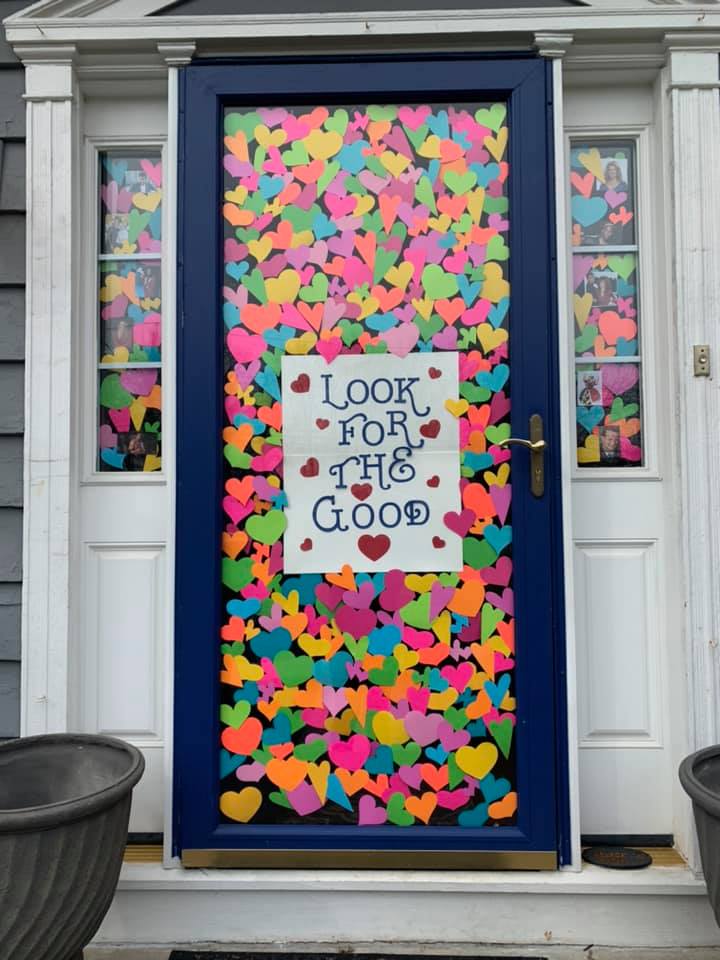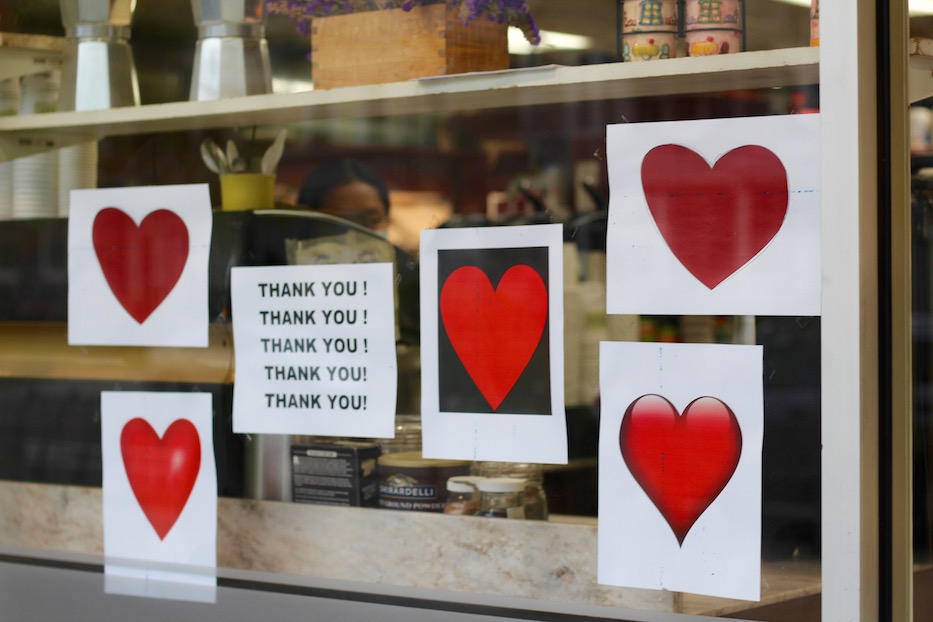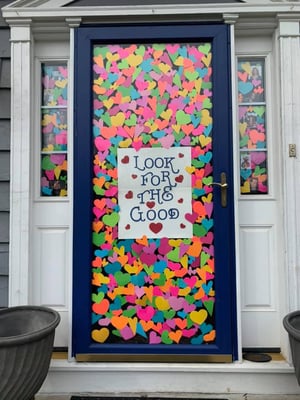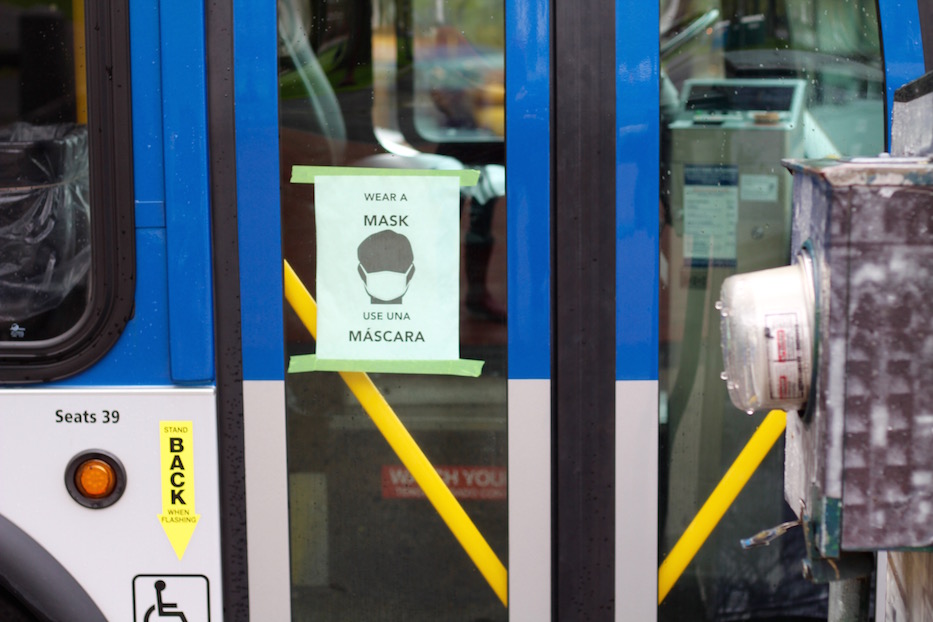
Culture & Community | Arts & Culture | New Haven Museum | COVID-19

| Hearts and signs thanking essential workers now cover the front windows at Nica's Market in East Rock. Lucy Gellman Photo. The second photo, from Morris Cover Michael DeLucia, is courtesy of the New Haven Museum. |
A suite of hearts swell from the window at Nica’s Market, looking out onto Orange Street. Behind the glass doors, the shop now allows five or fewer shoppers in at a time. The aisles are marked with red and yellow tape and one-way signs. At the checkout counters, masked and gloved cashiers wait behind plexiglass barriers.
It wasn’t always this way. But it’s starting to feel like a new normal.
It could also be the next primary source in “Documenting The COVID-19 Crisis,” a new initiative from the New Haven Museum to capture history as it is happening. The project comes as the museum, which has kept its staff members working from home, adds its voice to a growing chorus of cultural institutions trying to help remotely.
“If it doesn’t get saved, that means it’s not going to be remembered,” Executive Director Margaret Anne Tockarshewsky said in an interview Wednesday. “It’s important to have a record of resilience in New Haven. We want to have as many voices as possible.”
It joins the museum’s ongoing virtual “Microhistories” exhibition in knitting past to present, and present to future. Before the New Haven Museum was the New Haven Museum, it was the New Haven Colony Historical Society, founded in 1862 to track the city’s progress and preserve a record of its history.
In the 158 years since, it has collected newspapers, journals, photographs and material objects from the homes of New Haven’s makers, soldiers in both World Wars (two exhibitions in 2018 showcased some of that work), New Haven residents during the Spanish Flu pandemic of 1918, and the artists, innovators, and everyday counterculture heroes who make the city tick.
Director of Photo Archives Jason Bischoff-Wurstle, who has been assembling the microhistories, suggested that a record into the past can leave a city better equipped to talk about and deal with its future. In 1918, the city was better prepared for the Spanish Flu than some of its regional counterparts because it had mobilized for the World War I effort.

He doesn’t know what historians will write about Yale-New Haven Hospital’s coronavirus treatment, or how the city fared in federal relief efforts, or how New Haveners responded across the city’s 18.7 square miles, in 100 years. But he can collect the materials that will help tell that story.
“However things play out, these pieces become collection pieces, but they also become primary documents,” he said. “Collection pieces are wonderful, but pulling out a newspaper from 100 years ago, pulling out a journal—that’s the guts of things. It’s an interesting time period right now to think of what will become canon going forward.”
Specifically, Tockarshewsky added, the museum is interested in digital testimonies, photos, and everyday observations from New Haveners who are living through the pandemic. After launching the initiative last week, the museum has been trying to spread the submission platform as widely as possible.
The form, which is digital, has seven questions and a space for media uploads. They range from the basic (”When did you first hear about the coronavirus?”) to the personal (“Are you or any of your loved ones sick at this time? Can you describe the experience?”).
“When we come out of this, we’re going to be changed in so many different ways,” Tockarshewsky said.
For both of them, the pandemic also hits home. Tockarshewsky has family in Long Island and Queens, the latter of which is the epicenter of the epicenter of the pandemic. The last time she saw her Queens-based parents was in early March, a week before a wave of closures rippled through the tristate area.
She recalled telling them that she wasn’t sure when she would see them again in person, to which “they kind of gave me a funny look.” One week later, everything closed by state order. Two weeks later, Queens had become a hotspot in a global pandemic. As she isolates in New Haven, she said she worries about them constantly.
Bischoff-Wurstle and his wife have been navigating the pandemic with their young son, who he called a a bright spot in a world where the news cycle is increasingly grim (“he doesn’t really know what’s going on, he just misses his friends,” he said). When he isn’t working remotely for the museum, he’s being a dad. To track time while working from home, he also documents the sunrise almost every morning from his backyard.
“I mentioned that idea of solace and history,” he said. “I voraciously read the news, and I take a long view of it.”

| A primary source? All buses now sport these signs. Lucy Gellman Photo. |
While the museum may eventually collect objects as well—a pair of latex gloves, COVID-19 journal, or sewing machine that pumped out hundreds of masks, for instance—Tockarshewsky said that step is likely years away.
In the meantime, submissions have begun to come in from museum enthusiasts who saw the project posted on social media. One, from Morris Cover Michael DeLucia, shows a front door and windows covered entirely with bright paper hearts. "Look For The Good," it urges.
“It’s just starting,” Tockarshewsky said of the project. “We had heard from volunteers and board members that they were documenting this in some way. As we pointed out, it is the primary sources that historians are looking for in the future. We owe it to our future selves.”
The museum is also thinking about what its future self may look like. Currently, the New Haven Museum manages two properties: its main Whitney Avenue site and the historic Pardee-Morris House in the city’s Morris Cove neighborhood. Tockarshewsky said her first priority is making sure that the museum is financially stable enough to keep on staff, and care for the wellbeing and security of the collections.
As the state assembles a reopening task force, she is also in a number of discussions with museum directors and curators across the country about what reopening may look like and when it may happen. Some of those directors have suggested timed entry. Others have noted that they will need to reopen their spaces in stages, with staggered shifts for staff.
She is trying to see it as an opportunity to foster new community partnerships. She and staff have been looking at artists in community “who are already being co-creative,” for instance, and seeing how the museum can collaborate with them in the future.
“Necessity breeds ingenuity,” Bischoff-Wurstle said. “You see that across the board with bars, restaurants, and so on. Innovating is how they’re going to survive. Life before March is over. From that same notion, it can be a positive thing. It gives us a chance to change the things that weren’t working.”
To contribute to "Documenting The COVID-19 Crisis," click here.

